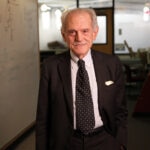Frontiers of Knowledge Award goes to the scientist who revolutionized the design and manufacturing of electronic chips
Alberto Sangiovanni Vincentelli, a Professor at the University of California in Berkeley, was presented the BBVA Foundation Frontiers of Knowledge Award in Information and Communication Technologies for “radically transforming” the design of chips that power today’s electronic devices, leading to “the modern semiconductor industry.”

“By providing software tools to ease the creation of complex chips, he made possible the worldwide explosion of integrated circuit design, spanning research, industry and academia,” the committee citation notes.
In addition to making transformative scientific contributions, Sangiovanni Vincentelli co-founded two companies, Cadence and Synopsys, which “collectively drive the entire semiconductor industry,” the citation underscores, as a result of his “design tools that are used in every single computer chip built today.”
The award recipient transformed chip design thanks to three fundamental contributions. First, he proposed a method to accelerate electronic circuit simulations, which proved to be essential to turning them into a truly useful tool. He also developed a system to automatically generate circuits based on hardware description languages. Finally, he created a program to distribute the multiple circuit components in a way that maximized performance and minimized energy consumption.
Ronald Ho, Senior Director of Silicon Engineering at Meta and secretary of the award committee, defines Sangiovanni Vincentelli as the “enabler of the chip industry, whose contributions have transformed the world of electronics,” on which all devices and technological systems present in our everyday lives are based - from personal computers to mobile phones right up to the microprocessors installed in automobiles, planes and electrical appliances: “You can see the durability of his ideas because the two companies he founded to allow their industrial implementation are now driving the semiconductor industry. The chips we use today were built from the ideas that Sangiovanni Vincentelli put together.”
“When we think back to the beginning of the computer industry,” says Ho, “silicon chips were relatively simple, since they had few transistors and could be designed by hand. Today, in a modern smartphone, chips have billions of transistors, so, how did we get from doing chips by hand with a few thousand transistors to today’s complex chips? Well, the answer is through the work of the man receiving the award.”
Circuit simulation to “test” chips pre-fabrication
A chip is a silicon wafer on which many transistors and other miniature electronic components are laid out to form a circuit. It is these electronic circuits that run the complex calculations of our home computers, display the TV channel we press on the remote control, or turn on a warning light when our car’s tire pressure is low.

Prof. Alberto Sangiovanni Vincentelli, University of California in Berkeley
To perform all these functions on the electronic devices we use each day requires a specific set of transistors arranged in just the right way. When Sangiovanni Vincentelli began his research, this layout process was done by hand, selecting each component, connecting them together to form a circuit to the right specifications and checking that they did what they were meant to do.
Chips, even then, had hundreds of transistors so the work was slow and laborious – “very, very boring” according to the awardee – with the risk of error looming at every stage.
Sangiovanni Vincentelli realized that his numerical analysis skills could help accelerate the simulation, and designed a new set of algorithms which, he says, “provided a new way of looking at the solution of the equations.” Now, it was possible to simulate even a complex circuit in a reasonable timeframe, verifying its correct operation in a matter of seconds. This also meant a huge cost saving, as the circuit’s integrity could be checked before proceeding to its physical fabrication.”
Circuits designed using simple programming commands
The awardee also greatly simplified the creation of the circuits themselves. To conduct an operation as basic as adding two numbers, a circuit may require millions of components. And choosing which to use and how to arrange them is complicated work. “The process of circuit design involves a series of steps starting with its ideation, what I want to achieve, and ends with its implementation in a tiny piece of silicon,” the new laureate explains. “Once you define precisely, mathematically, what these steps look like, you can build software tools that actually automate them,” he adds.
And so, his second contribution was the invention of a program that can generate circuits through simple programming commands. Thanks to this insight, it is possible to design a circuit simply by formulating the task to be performed in a language understood by a computer, which then automatically generates the set of components needed for its execution.
Furthermore, the award recipient developed ways of automatically verifying that the components generated for the chip design corresponded to the circuit function formulated by the code. Without this check, errors might get overlooked among the profusion of circuit components.
Optimization of chip design with minimum human intervention
Finally, Sangiovanni Vincentelli noticed that the geometrical arrangement of all these components could be key to delivering higher performance or lower energy consumption. He also automated this stage of the circuit design process, developing algorithms that proposed an optimal placement for best performance or energy efficiency.

With these three contributions, the awardee enabled what he describes as “the design of very complex circuits with minimal human intervention,” thus allowing people to concentrate on the creative side of the design process without having to bother with the more tedious, and highly error-prone, details.
And thus, the work of Sangiovanni Vincentelli has opened the door to the manufacture of vastly more complex chips than in the past. “In 1975,” he recalls, “the largest chip had about 2,000 transistors, and now they are packed with more than two billion.”
The three contributions that have marked his career may seem like “a straightforward set of steps,” says Ho, “but each one of them was foundational and started an entire area of research in the silicon industry.”
A leader in the world electronics industry
Sangiovanni Vincentelli is not just a “prolific inventor” and “outstanding educator,” in the words of the committee, who founded a worldwide school of thought from his base at Berkeley, his influence has extended beyond the university into the leading edge of industry.
The award recipient confesses that he does not, however, see himself as “an entrepreneur because an entrepreneur is a guy who has this brilliant idea, and then founds a wonderful company.” But it didn’t happen that way in my case.”
In fact, the tools developed by the award-winner attracted the attention of many companies as early as the 1980s, which began to use them because they were freely available to anyone interested. It was these very firms that persuaded Sangiovanni Vincentelli to move into business to market his circuit design solutions.
And so, in 1983, Cadence was founded, followed in 1987 by Synopsys. Both companies started with an initial staff of just three people, but nowadays, they are multinational companies with offices around the world employing upwards of 10,000 people. “At first they were complementary,” he recalls, with each one dealing in a different side of the design process. But by 1991 they started competing, so I had to choose the company I would continue to work with. It was a hard decision, but I stayed with Cadence,” where he continues serving on the board and acting as a technical advisor. “It’s like one of my children,” he reflects.
Nowadays, both companies are fundamental in the silicon industry, providing technology to clients ranging from Apple to Intel, Tesla or Boeing. “Every single digital chip, everyone in the industry, uses tools from either Cadence or Synopsys, usually both,” says Ho.
But Sangiovanni Vincentelli has always believed that his discoveries should be made available to whoever wishes to use and build on them, putting the advancement of knowledge before any economic interest. “We are a university, our mission is to teach people, but also to advance science. And how can you advance science if you don’t let people use your work?” he contemplates.
As such, the tools he has developed are open source, meaning anyone can use them to improve their chip design. The success of his companies relies on offering solutions based on university research but geared specifically to the client’s needs.